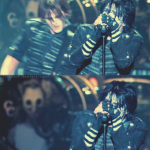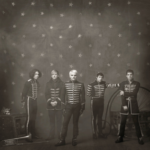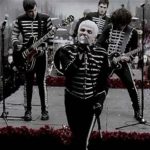On March 1st we began the process of moving to Los Angeles to continue with preproduction. We left NYC because we felt that we needed a change of scenery. When we arrived in Los Angeles, we moved into an extremely haunted mansion called ‘The Paramour.’ This house had a huge history of odd and mysterious things occurring inside.
Some of us laughed it off; others (cough, cough, me) found the house frightening. As luck would have it, I would end up in the scariest (and later found from past residents) and most haunted room. To add to it, there was a single light bulb hanging from the ceiling that didn’t provide light, but an eerie glow. Dogs barking at thin air, doors slamming in front of people (Frankie and Gerard) and bathtubs filling with water when no-one was home (Bob).
We set up shop in a huge ballroom, chock full of creepy paintings, furniture, and statues. The material started to flow and coincidentally, the sound became more sinister, and the riff and lyrics more biting. Songs such as ‘This Is How I Disappear’ and ‘Mama’ had these booming sinister sections. Songs such as ‘Sleep’ and ‘Famous Last Words’ poured out. ‘I Don’t Love You’ became even more biting and sorrowful (as if it wasn’t already). Song after song was painted beautifully and painfully. We took out every frustration, screamed for every hope, and spoke out of our minds, night after night.
This Is How The Story Ends.: My Chemical Romance and the Death of Emo – MSN Interview
The article began its incendiary report rather matter-of-factly: “A girl of 13 killed herself after becoming obsessed with a fashion which links death with glamour, an inquest heard. Hannah Bond hanged herself from her bunk bed with a tie after becoming an ‘Emo.’”
The date was May 9, 2008 and the British paper the “Daily Mail” was reporting on the sudden suicide of a teenage girl after her parents wouldn’t let her sleep over at a friend’s house. Though her musical tastes were certainly put into question by the coroner, with its next sentence the paper would set off a firestorm of controversy and anger whose ripples can still be felt today: “Emo fans wear dark clothes,” it read. “Practise self-harm and listen to ‘suicide cult’ rock bands.”
And there it was, an assumption by a journalist aiming to drum up publicity with little to no proof. The article went on to name only one band in its attack on ‘Emo.’
“One of the foremost of these “suicide cult” bands is My Chemical Romance, from New Jersey,” the last paragraph begins before describing the success the band’s concept album, ‘The Black Parade,’ had attained in the UK. It concludes with a final, ignorant interpretation of the concept: “The Black Parade is a nickname for the place where Emo fans believe they will go when they die.”
With that the members of My Chemical Romance — a band at the height of their fame whose message, especially on that album, their biggest commercial success to date, was of positivity in the face of death — affectively became the target for thousands of frustrated mothers looking for someone or something to blame. The fallout was epic.
“I thought if we made an album that tried to change the world, or give it hope, it would really happen,” lead singer Gerard Way recently told Spin Magazine. “But all people found was death and destruction and misery and self-hate. I learned the world doesn’t want to be saved, and it will f—cking punch you in the face if you try.”
It was with this mentality — emotionally broken, artistically strained — and at the height of their popularity, that the band began getting work on a follow up. With its lead singer and songwriter’s guilt weighing heavily on its shoulders, My Chemical Romance set out to create “the polar opposite of the Black Parade” and, in turn, release itself from the dreaded tag that hung like a noose tightly around their necks.







